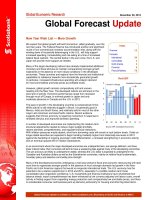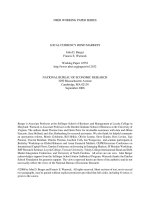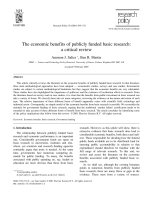Economic research securitisation 2010
Bạn đang xem bản rút gọn của tài liệu. Xem và tải ngay bản đầy đủ của tài liệu tại đây (385.96 KB, 8 trang )
In partnership with:
IFSL RESEARCH
APRIL 2010
SECURITISATION 2010
OVERVIEW
Activity in global securitisation markets in 2009 was dominated for the
second successive year by repurchase operations of central banks. These
issues, designed to boost credit and liquidity, kept gross securitisation
issuance at high level of $2,860bn, up from $2,764bn in 2008. Excluding
these funding operations, net issuance* sold into the market and purchased
by end-investors, was much lower although it recovered slightly to $548bn
in 2009 from $439bn the previous year (Chart 1).
The value of annual net issuance therefore remains a fraction of that before
2008. The global market for securitisation has slumped since the autumn
of 2007 due to turbulence in credit markets, a lack of liquidity and a
reduction in investors’ tolerance of risk. The background to the crisis is
summarised on page 2.
WWW.IFSL.ORG.UK
Chart 1 Global net securitisation issuance*
$bn, annual net issuance
$bn, quarterly net issuance
600
2250
Asia
Europe
US
2000
1750
500
400
1500
1250
300
1000
200
750
US
500
100
Europe
250
Asia
Recent quarterly data shows a modest recovery of net issuance in the US *Excluding securitisation issues retained by the issuing banks
during 2009 with totals well in excess of $100bn in the final three quarters Source: Dealogic
of 2009, having risen from a low of $13bn in Q4 2008. The annual US
total of $463bn contrasts with more depressed markets elsewhere,
particularly Europe where net issuance dropped to $27bn in 2009 from $67bn
in 2008 and $455bn in 2007.
Leading industry groups in the securitisation industry have been working
together to develop market-led solutions to restore investor confidence in
securitisation. Specific initiatives in Europe have included support for
standardising securitisation products and improving issuer disclosure and
investors' due diligence practices.
The US market for mortgage finance has been supported by the federal
housing agencies and also the $200bn Term Asset-Backed Securities Loan
Facility (TALF) designed to facilitate buying of asset-backed securities. This
may have contributed to the partial recovery in US net issuance that is not
evident elsewhere.
Country breakdown for gross issuance shows that US remained the leading
issuer in 2009 at $2,113bn, over 90% of which was based on MBS (Chart 2).
Issues in Europe totalling $577bn were only just over a half of the previous
year but remain inflated by the repurchase schemes operated by the central
banks. The UK was again the largest European issuer in 2009 but funding of
banks’ was much reduced and the UK’s share of the European market
therefore dropped to 21% from 38%. Continuing stimulus to liquidity
contributed to gross securitisation in Canada of $57bn. Issuance in Australia
at $21bn was slightly higher than 2008 but much lower than previous years.
0
2007
2008
2009
2007
2008
0
2009
Chart 2 Gross securitisation issuance
Assets securitised, $bn
4000
3000
US
2000
1000
0
2000 2001 2002 2003 2004 2005 2006 2007 2008 2009
Assets securitised, $bn
1100
Europe
1000
900
800
700
600
500
400
300
200
100
0
Australia
Japan
2000 2001 2002 2003 2004 2005 2006 2007 2008 2009
Sources: Securities Industry and Financial Markets Association,
European Securitisation Forum, Reserve Bank of Australia,Fitch Ratings
*Dealogic data on net issuance and AFME/ESF data on gross issuance are compiled on a
different basis so are not directly comparable
1
IFSL
SECURITISATION IN THE US
Since the securitisation crisis broke in the autumn of 2007 federal supported
mortgage backed issuance has dominated activity in the US market with
other issuance also dependent to some extent on federal support.
Mortgage-backed securities (MBS) Since the Federal Housing Finance
Agency placed the two larger agencies, Fannie Mae and Freddie Mac, into
conservatorship (the US equivalent of nationalisation) in 2008 the US
government has ensured an ongoing supply of affordable mortgage finance
while taking responsibility for the two agencies’ liabilities in excess of
$5,000bn. It has stabilised the agencies and reduced the growing systemic
risks to the mortgage finance system. By early 2010 the Fed had purchased
$1.25 trillion of agency MBS in a purchase program intended to supply low
cost finance for the housing market. This program came to an end in March
2010. Other forms of support to the housing market such as home buyers’ tax
credits have also been important in sustaining demand for mortgage finance.
Statistics compiled by the Securities Industry and Financial Markets
Association (SIFMA), indicate that MBS rose nearly a half to $1,957bn in
2009, from $1,344bn in 2008, bringing MBS much closer to the value of
issuance in the two previous years (Chart 3). Agency MBC reached $642bn
in Q2 but fell away in the second half dropping to $395bn in Q4 (Chart 4).
Ginnie Mae, which has always had a government guarantee, has with
federal assistance taken a much larger share accounting for nearly a quarter
of the agency market in 2008 and 2009, up from around 9% in the three
previous years (Chart 5). The delinquency rate for Ginnie Mae, at 9.1% at
end-2009 for mortgages over 90 days in arrears, was much higher than
Fannie Mae 5.3% and Freddie Mac 3.9%.
Collateralised mortgage obligations (CMOs), also based on agency issuance,
increased from $129bn to $228bn in 2009. Private label or non-agency MBS
has sunk to a low ebb with issuance down to $45bn in 2008 and $32bn in
2009, from $774bn in 2007. Some issues in the past two years have required
support from TALF, a $200bn lending programme created by the Federal
Background to the crisis in global securitisation markets
The global market for securitisation slumped in the autumn of 2007 due to turbulence
in credit markets, a lack of liquidity and a reduction in investors’ tolerance of risk.
These difficulties were triggered by the sub-prime crisis and compounded by the
downfall of Lehman Brothers, as well as the nationalisation of the US federal agencies - Fannie Mae and Freddie Mac.
The problem in the sub-prime market originated from the package and sale of many
sub-prime mortgage loans to investors through mortgage-backed securities (MBS).
Many securities defaulted had been given an overly high credit rating by the rating
agencies. Contagion was spread further because MBS were sold on to investors,
through collateralised debt obligations and structured investment vehicles. Some
investors, particularly a number of banks, acquired a vast quantity of these assets,
which became toxic. Many investors exited the market contributing to limited
issuance in the US and European securitisation market beyond issues made by the
federal agencies. The weakening of banks’ balance sheets caused by holdings of large
tranches of MBS and ABS has resulted in substantial recapitalisation of all banks, not
just those directly affected by investment in toxic assets.
2
Securitisation 2010
Table 1 Securitisation issuance based on
originating country or region
Annual value of gross issuance, $bn
2005 2006
2007
3175 3298
US
3000
76
Australia
91
67
81
Japan
83
76
25
Canada
29
45
2008
1508
18
58
77
2009
2113
21
50
57
157
41
50
49
1
19
1
9
9
63
8
407
242
38
55
36
3
47
13
7
10
143
10
604
237
36
84
56
6
26
14
15
5
132
12
622
400
121
119
107
51
74
60
22
21
41
32
1047
123
95
87
61
38
37
19
18
10
58
31
577
28
South Korea
4
Other Asia
14
Latin America
Emerg. mkts total 46
24
6
20
50
21
3
20
43
19
19
18
55
28
10
14
52
3818
4155
3854
2764
2870
UK
Italy
Spain
Netherlands
Belgium
Germany
Ireland
Portugal
France
Pan-Europe
Other Europe
Europe total
World total
Sources as listed in subsequent charts and tables
relating to countries and regions
Chart 3 Issuance of mortgage-backed
securities in the US
US MBS annual gross issuance, $bn
3200
Private label
CMO
2800
Agency backed
2400
2000
1600
1200
800
400
0
1997
1999
2001
2003
2005
2007
Source: Securities Industry and Financial Markets Association
2009
IFSL
Reserve to provide financing for US entities that purchase newly issued
securitisations, including credit cards, auto loans and commercial mortgages.
Asset-backed securities in the US (ABS) ABS issuance, in common with
private label MBS, has fallen substantially since mid-2007 having
previously risen steadily since 1990. Annual ABS issuance has fallen from a
peak of $1,166bn in 2006 to $164bn in 2008 and to $155bn in 2009
(Chart 6). Issuance fell from $615bn in the first half of 2007, to a low of
$31bn in the second half of 2008 (Chart 4). Since then there has been a
modest recovery with issuance totally $72bn and $84bn in the two halves of
2009. TALF has supported some ABS during 2009, but TALF for consumer
ABS came to an end in March 2010.
Sectors to have experienced a particularly sharp fall are home equity and
CDOs each have fallen from over $200m in 2007 to $6m and $2m
respectively in 2009 (Table 2). The market in both these sectors was closed
in the second half of the year with no issues at all. A moderate volume of
activity in credit cards, auto and student loans continues.
Restoring investor confidence in securitisation markets
Global initiative The Securities Industry and Financial Markets Association
(SIFMA), the American Securitization Forum (ASF) and the European Securitisation
Forum of the Association for Financial Markets in Europe (AFME/ESF) have formed
a global, joint working group that will create and publish recommendations designed
to help revitalize the securitization and structured credit markets, and bolster investor
and broader public confidence in those markets. The goals of this initiative include
improving the operation and function of these markets in ways that enhance market
discipline and transparency, while preserving the essential role that securitisation
plays in funding consumer and business credit needs.
European initiative In Europe the securitisation industry has been focusing during
the market turmoil on developing market-led solutions to restore investor confidence
in securitisation. Initiatives led by the AFME/ESF have focused on developing market-led solutions to restore investor confidence in securitisation. These initiatives
seek to enhance transparency by improving access to and quality of data, and to
develop market practices for better market infrastructure to ensure a more sustainable
and robust European securitisation market in the future. Specific initiatives include:
- Support for standardisation of securitisation products;
- Improving issuer disclosure and investors' due diligence practices; and
- Reducing information asymmetries and improving alignment of incentives between
originators, investors, and other market participants.
These initiatives are seeking to address the factors that contributed to the crisis. These
factors included deterioration in
loan underwriting standards,
Table 2 ABS sectors in the US
overreliance on credit ratings,
growth of complex highly Annual issues, $bn
2005 2006 2007 2008 2009
leveraged positions, misjudg484
4
460
6
217
Home equity
ment of liquidity risk, lack of a CDOs
412
25
199
2
344
sense of shared responsibility Auto
82
36
85
62
74
67
59
68
46
100
and rising losses in the US sub- Credit cards
67
28
63
22
61
prime markets which triggered Student loans
54
12
77
17
58
Other
the global crisis in confidence.
164 156
952 1166
854
Total ABS
Source: Securities Industry and Financial Markets Association
Securitisation 2010
Chart 4 US issuance of MBS & ABS
Quarterly issuance of US MBS & ABS, $bn
700
Agency
MBS
600
500
400
300
200
100
ABS
Non-agency
MBS
0
2007
2008
2009
Source: Securities Industry and Financial Markets Association
Chart 5 US issuance of agency-backed MBS
Agency-backed MBS issued in the US each year, $bn
2100
FHLMC
FNMA
1800
GNMA
1500
1200
900
600
300
0
1997
1999
2001
2003
2005
2007
2009
Source: FHLMC (Freddie Mac), FNMA (Fannie Mae), GNMA (Ginnie Mae)
Chart 6 US issuance of asset-backed securities
$bn, annual issuance of ABS
1200
1000
800
600
400
200
0
1997
1999
2001
2003
2005
2007
Source: Securities Industry and Financial Markets Association
2009
3
IFSL
SECURITISATION IN EUROPE
Securitisation issuance in Europe in 2008 and 2009 has been heavily
influenced by the repurchase schemes operated by the Bank of England and
the European Central Bank. These repurchases have begun to be wound
down during 2009 as AFME/ESF data shows that gross securitisation in
European countries fell from $1,047bn in 2008 to $577bn in 2009 (Chart 6).
Much of this drop is due to scaling down of funding operations by the Bank
of England as UK issuance dropped from $400bn to $123bn.
Over 90% of deals in 2009 were retained by originators and sellers of debt
and not sold on to investors. This is demonstrated by Dealogic figures which
indicate that net issuance in the European primary market more than halved
to $27bn in 2009 from $67bn in : and were 94% down on $455bn in 2007
(Chart 7). AFME/ESF reports that fundamental issues are still preventing a
recovery of the securitisation market including a reduced investor base;
availability of more competitive sources of funding; and an overhang of
retained issuance.
After the UK, the next largest issuers in Europe in 2009 were Italy, Spain and
the Netherlands (Table 1). The proportion of pan-European issues that cannot
be attributed to individual countries was 10% in 2009.
The banks’ funding requirements have meant that securitisations were more
heavily skewed to RMBS in 2008 and 2009 than was previously the case
when the primary market was functioning normally (Table 3). There was a
pick up in CDOs in 2009.
Spreads and ratings A lack of liquidity, increased credit risk and limited
demand from investors contributed to a sharp jump in spreads from the third
quarter of 2007. Spreads continued to rise through 2008 and the first half of
2009 but began to ease in the second half of that year. For example, spreads
for AAA-rated European ABS auto loans, previously at around 10 basis
points (bp) between 2004 and mid-2007, rose steeply to reach over 400bp
during the second quarter of 2009 (Chart 8). However, spreads subsequently
halved to around 200bp in November and December. Spreads for AAA-rated
credit cards peaked even higher at 700bp in Q2 2009 but were down to less
than 300bp by end-2009.
The number of downgrades to European securitisation issues doubled to
2,216 in 2009 from 1,174 in 2008. Upgraded issues halved from 184 to 86
between 2008 and 2009. The downturn in the securitisation market is
demonstrated in the contrast with 2007 when 481 upgrades were more than
double the 214 downgrades (Chart 9). The Q4 2009 total of 677 downgrades
was slightly down on the 728 in Q4 2008.
Securitisation 2010
Chart 7 Securitisation issuance in Europe
Annual issuance, $bn
- bars: gross MBS & ABS issuance
- line: net issuance for 2007-2009
1100
1000
900
Mortgage-backed securitisation
Asset-backed securitisation
800
700
600
500
400
300
200
100
0
2000 2001 2002 2003 2004 2005 2006 2007 2008 2009
Source: European Securitisation Forum, Dealogic
Table 3 European securitisation by
type of collateral
Issuance, $bn
RMBS
CMBS
MBS total
CDO
Other ABS
Europe total
2005
180
61
241
15
151
407
2006
307
75
383
138
83
604
2007
356
65
421
122
79
622
2008
862
7
869
71
107
1047
2009
333
22
355
149
73
577
% share
RMBS
CMBS
MBS total
CDO
Other ABS
Europe total
44
15
59
4
37
100
51
12
63
23
14
100
57
10
67
20
13
100
82
1
83
7
10
100
58
4
61
26
13
100
Source: European Securitisation Forum
Chart 8 Spreads on AAA-rated European ABS
Basis points at mid-year & end-year on 1-4 year auto loans
400
350
300
250
200
150
100
50
0
2002 2003 2004 2005 2006 2007 2008 2009
Source: Fitch Ratings, European Securitisation Forum
4
IFSL
SECURITISATION IN REST OF THE WORLD
Australia Issuance of securitised bonds by Australian issuers has been
substantially curtailed from mid-2007, although the second half of 2009
provided some evidence of a nascent recovery (Chart 10). Having declined
from $68bn in 2007 to $18bn in 2008, issuance picked up slightly to $21bn
in 2009. The bulk of the issues in 2008 were purchased by the Australian
Office of Financial Management (AOFM) as part of the Australian
government’s injection of liquidity into financial markets. However, there
has been less dependence on AOFM with four out of five RMBS issued in
recent months amounting to A$5.3bn not requiring AOFM as a cornerstone
investor. Less than 10% of issuance required AOFM support, down from
80% in the first half of the year.
The pick up in investor demand is helped by the relatively high quality of the
underlying assets and is reflected in declining spreads. There has also been a
substantial narrowing of the gap between secondary and primary market
spreads, suggesting that the market has worked through much of the
overhang of supply created by the liquidation of structured investment
vehicles. MBS, particularly RMBS, remains the mainstay of the Australian
market, accounting for 82% of issuance in 2009. There was no offshore
issuance in 2009, which up to 2007 had accounted for around half of
issuance.
Canada Although Canadian banks did not invest significantly in the
securitisations which became toxic to the balance sheets of many US and
European banks they have faced liquidity constraints in the wholesale
funding market. The Bank of Canada in 2008 therefore committed to
purchasing up to C$75bn of insured mortgage assets through the Canada
Mortgage and Housing Corporation. These helped underpin term-backed
ABS and MBS in 2008 and 2009, which otherwise has been significantly
impaired. Gross securitisation in Canada in 2008 fell back to $57bn in 2009
from $77bn in 2008, having jumped from $45bn in 2007 (Chart 11).
Previously, securitisation in Canada had grown steadily and become
increasingly broad-based since its inception in the mid-1980s.
Japan Securitisation in Japan fell to an estimated $50bn in 2009 from $58bn
in 2008, having dropped by a quarter from $76bn in 2007 (Chart 9). In 2008,
volume declined significantly across all asset types especially CMBS, where
the decline in transactions was caused by a lack of liquidity in the real estate
finance market.
Latin America In Latin America Moodys estimate that issuance fell from
$18bn in 2008 to $18bn in 2009 (Chart 13). Activity in Latin America has
been less affected by the credit crunch, as the markets have ben less exposed
to CDOs and subprime mortgages. International issues have fallen away in
the past three years from from $4.6bn in 2007 to $0.5bn in 2009, with local
issues therefore predominating. Brazil was the largest issuer in 2009 with
$5.0bn, followed by Mexico $2.8bn and Argentina $2.6bn.
Asia South Korea remains the biggest issuer in Asia after Japan. Issues
Securitisation 2010
Chart 9 Ratings changes on European securitisation
Number of upgrades & downgrades of European securitisations
750
Downgrades
600
450
300
150
Upgrades
0
2007
2008
2009
Source: Fitch Ratings, European Securitisation Forum
Chart 10 Securitisation issuance in Australia
$bn
90
ABS
MBS
80
70
60
50
40
30
20
10
0
2000 2001 2002 2003 2004 2005 2006 2007 2008 2009
Source: Reserve Bank of Australia
Chart 11 Securitisation issuance in Canada
$bn
80
70
60
50
40
30
20
10
0
1999 2000 2001 2002 2003 2004 2005 2006 2007 2008 2009
Source: Bank of Canada
5
IFSL
recovered to $36bn in 2009 from $21bn in 2008, having previously declined
steadily over a number of years from $40bn in 2001. Main types of
securitisation to benefit from the growth included MBS, non-performing
ABS and corporate ABS.
Since 2003, other Asian countries have entered the securitisation market
facilitated by the introduction of an appropriate legislative framework.
Issuance in 2009 was estimated at $10bn.
Securitisation 2010
Chart 12 Securitisation issuance in Japan
$bn
90
80
70
60
50
40
30
20
10
0
1999 2000 2001 2002 2003 2004 2005 2006 2007 2008 2009
Source: Fitch Ratings
Chart 13 Securitisation in emerging markets
Annual value of issuance, $bn
40
35
South Korea
30
25
20
15
Latin America
10
5
0
Other Asia
2001 2002 2003 2004 2005 2006 2007 2008 2009
Source: Fitch Ratings, Financial Supervisory Service (South Korea)
6
IFSL
Securitisation 2010
Securitisation and its main structures
Securitisation offers a way for an organisation to convert a future stable cash flow
arising from a financial asset, usually some form of loan, into a lump sum cash
advance. This is achieved by converting the future cash flows into tradable securities
which are sold as a means of raising capital. Securitisation markets have been in crisis due to a variety of factors. Industry proposals to restore viability by attracting a
new investor base are set out on page 3.
Mortgage-backed securities
Agency and private label mortgage backed securities are based on the ‘pass-through’
and have been the most common structure for US securitisation since the market was
developed in the 1980s. Under a pass-through the MBS issuer acquires mortgages
from the original mortgage lenders, which are then examined to ensure they meet
credit quality guidelines. Loans with similar characteristics with regard to yield and
maturity are pooled together and the servicer ‘passes through’ a pro rata share of all
interest and principal payments to the investors. The actual packaging or ‘pooling’
can be undertaken by the US mortgage federal agencies or by private enterprises.
Private label MBS are companies other than Fannie Mae, Ginnie Mae and Freddie
Mac that create and sell MBS or other bonds. Private label MBS has slumped by over
95% since the onset of the financial crisis.
Residential mortgage-backed securities (RMBS) are debt instruments secured by
residential property.
Commercial mortgage-backed securities (CMBS) are debt instruments secured by
commercial property such as offices, shops, factories and warehouses, as well as
blocks of flats and hotels. They enable banks to pool their commercial property loans
and repackage them.
Collateralised mortgage obligations (CMOs) CMOs were created because
pass-through securities don’t always match investor requirements, due to a lack of
certainty of cash flow and mismatch of maturities. CMOs were first issued in the
early 1980s and offered a full spectrum of maturities: banks and thrifts
wanted a shorter term instrument while pension funds and insurance companies
wanted long term securities.
Asset-backed securities (ABS)
ABS are bonds or notes backed by financial assets that have been issued in the US
since 1985. These assets consist of receivables, other than the mortgage loans, that
have been securitised. ABS therefore span home equity loans, credit card receivables,
car finance, collateralised debt obligations (CDOs), student loans, equipment leases
and manufactured housing contracts. CDOs refer to a debt obligation whose
underlining collateral and source of payments consist of existing bank loans and
other forms of debt obligations, such as emerging market and high yield debt.
7
IFSL
OTHER SOURCES OF INFORMATION
AFME/ESF
Securitisation Data Report (quarterly)
www.afme.eu
Securitisation 2010
IFSL Research:
Report author: Duncan McKenzie
Director of Economics, Duncan McKenzie
+44 (0)20 7213 9124
Bank of Canada
Weekly financial statistics
Financial System Review, December 2008
www.bankofcanada.ca
Senior Economist: Marko Maslakovic
+44 (0)20 7213 9123
International Financial Services London
29-30 Cornhill, London, EC3V 3NF
Financial Supervisory Service (South Korea)
Weekly Newsletter
www.fss.or.kr
Fitch Ratings
www.fitchratings.com
This report Securitisation 2010 is one of 15 financial sector
reports in IFSL’s City Business Series. All IFSL’s reports can
be downloaded at:
www.ifsl.org.uk
© Copyright April 2010, IFSL
Data files
Datafiles in excel format for all charts and tables
published in this report can be downloaded from the Reports
section of IFSL’s website www.ifsl.org.uk
Reserve Bank of Australia
Statement on Monetary Policy (quarterly)
www.rba.gov.au
Sign up for new reports
Securities Industry and Financial Markets Association (US)
Research Quarterly
www.sifma.org
If you would like to receive immediate notification by email
of new IFSL reports on the day of release please send your
email address to
Thomson Reuters
Debt Capital Markets Review (quarterly)
www.thomsonreuters.com
In partnership with:
International Financial Services
London (IFSL) is a private sector
organisation, with nearly 40 years experience
of promoting the UK-based financial services
industry throughout the world.
8
City of London Corporation administers
and promotes the world’s leading international
finance and business centre and provides free
inward investment services.
This brief is based upon material in IFSL’s possession or supplied to us, which we believe to be reliable. Whilst every effort has been made to ensure its accuracy, we
cannot offer any guarantee that factual errors may not have occurred. Neither International Financial Services London nor any officer or employee thereof accepts any
liability or responsibility for any direct or indirect damage, consequential or other loss suffered by reason of inaccuracy or incorrectness. This publication is
provided to you for information purposes and is not intended as an offer or solicitation for the purchase or sale of any financial instrument, or as the provision of
financial advice. Copyright protection exists in this publication and it may not be reproduced or published in another format by any person, for any purpose. Please
cite source when quoting. All rights are reserved.









